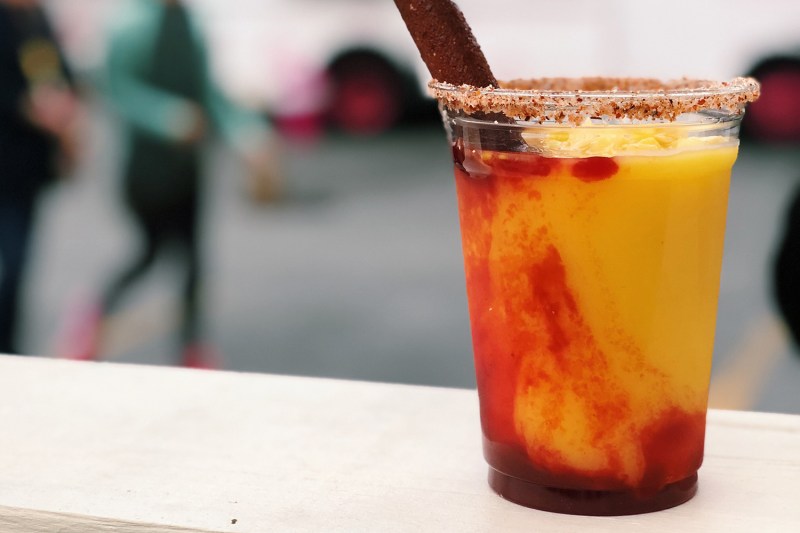Summer drinks call for boozy milkshakes for refreshing summer drinking. Everyone is eager to unwind under the sun by combining cocktail hour and dessert into a single entity. These frozen libations always experience a popularity boost during the warmer months; the resurgence of tiki culture (see Mai Tai drinks) has caused high-brow piña coladas and frozen zombies to appear on beverage lists across the nation.
However, frozen drinks often fall into the trap of excessive sweetness. Lots of pre-made mixes, lots of “fruit juices,” lots of sugary liqueurs. If you instead want an icy and refreshing beverage loaded with natural fruit, we have a suggestion for you: The mangoneada.
Related Guides
How to Make Mangoneada Slushy

Want to make your own mangoneada? Give this recipe from Antique Taco a shot (haha, see what we did there?):
When asked about her spirit-forward spin on the mangoneada, Brody told us that “[our] mangonada is the perfect evolution from a nostalgic childhood Mexican treat into a crushable cocktail. When I think about what I want to be sipping out on the Antique Taco patio during Chicago’s summer months, this drink is it. Our adult version of the mangoneada has all the original flavors of mango, lime, and chamoy, with a tequila twist. Summertime drinking perfection, if you ask me.”
Ingredients:
- 4 oz frozen mango
- 2 oz of mango syrup (Brody prefers Simple Squeeze Mango Reál Syrup)
- 2 oz of lime juice, strained
- 2 oz of tequila blanco
- 6 oz of water
- Tajín salt, chamoy, diced mango, tamarind straw (for garnish)
Method:
Combine ingredients in a blender. Rim a 16 oz glass with Tajín salt. Lightly pour chamoy onto the sides of the glass. Pour mangoneada in the glass and top with diced mango. Serve with a tamarind straw.
What is Mangoneada?

Also known as a chamango or mangonada, a mangoneada is a Mexican beverage that conveniently doubles as a dessert. It’s based around mangoes (as the name suggests), with fresh mango forming its foundation, and some renditions also supplement with mango sorbet. Lime juice adds some citrusy tang, and the “secret ingredient” comes in the form of chamoy, a savory Mexican condiment made from dried fruit and powdered chile. After blending the ingredients with a large scoop of ice (or pre-freezing your mango), you get a slushy-style treat packed with fruit flavor and a hint of spice.
In addition to its homeland of Mexico, mangoneadas are proving popular in areas throughout the U.S. with sizable Mexican populations, particularly midwestern states like Illinois and Colorado, southwestern areas like New Mexico and Arizona, and major border regions like Southern California and Texas.
While the mangoneada isn’t inherently an alcoholic drink, many bartenders like to add a spirited kick to this classic cool-down. Tequila tends to be the spiking liquid of choice, although some mixologists prefer the neutrality of vodka.
Why Does Mangoneada Deserve More Attention?
“Tequila, fresh mangos, spicy chamoy, and tangy lime make for a refreshing drink that screams verano (summer). Mangoneadas are a quintessential Mexican treat,” San Antonio-based chef Johnny Hernandez of La Gloria tells The Manual. “I first discovered them in Mexico City and after experiencing my first mangoneada, I always made my way back to the vendors on the streets of Mexico City to get my fix.”
Because of its bold flavors and its relieving properties during spells of hot weather, the mangoneada makes a worthy substitute for more typical summertime libations. “When we first came upon this drink in our research we were a little skeptical about how it would be received but it quickly became a house favorite. The chamoy has a slightly sour-sweet [quality that] blends so well with the tart sweetness of mango. We still felt it was missing something, so we added [extra spice] and we knew we found our mangoneada!
This cocktail is complex while still being very refreshing in our hotter months. The mangoneada is worth a try if you are looking for a fun spin on a margarita without all the sweetness,” explains bar manager Rena Day of Bésame in Steamboat Springs, Colorado.



